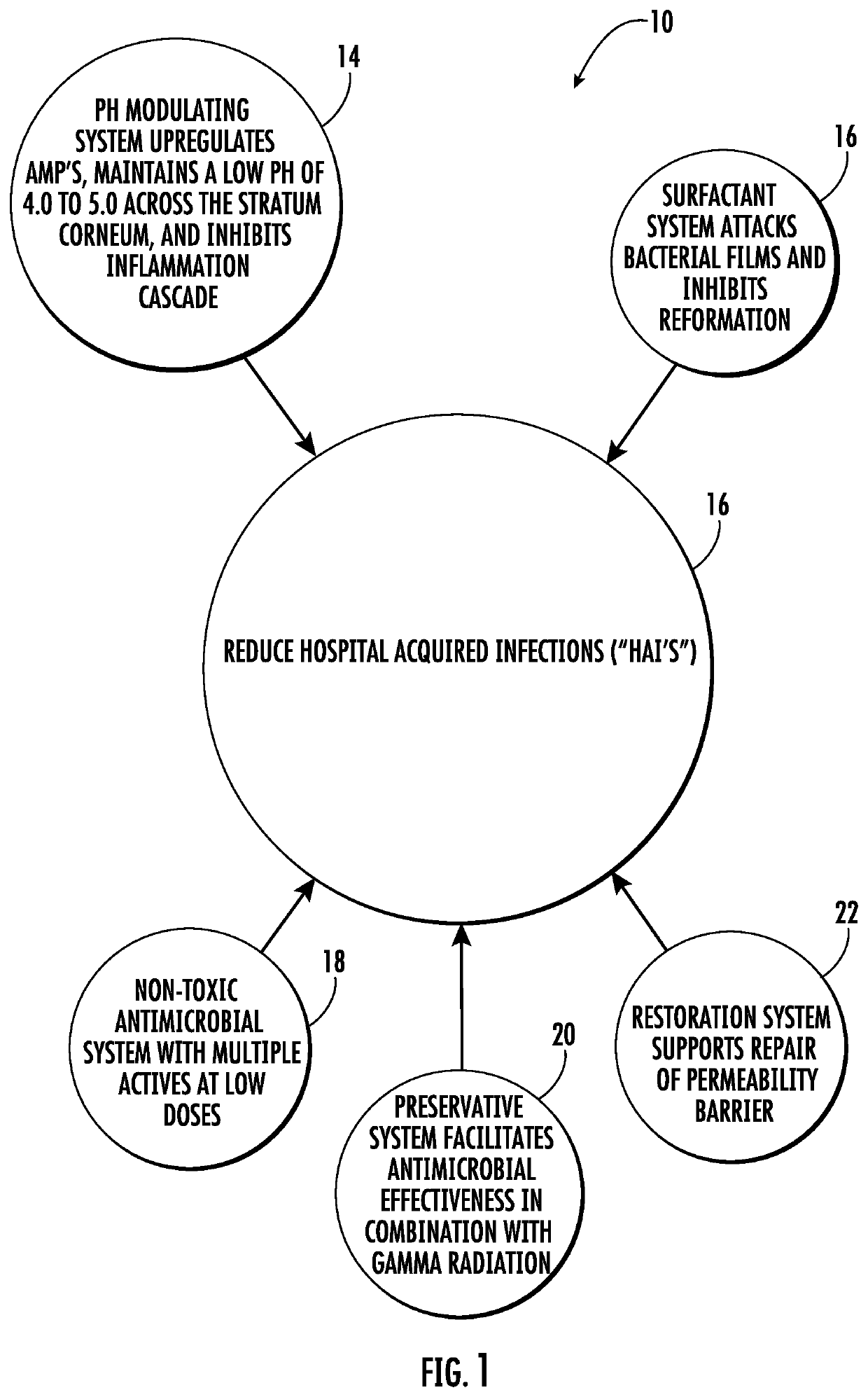Compositions and methods for the antiseptic treatment of biofilms on mammalian tissue
a technology of biofilms and compositions, applied in the direction of antinoxious agents, drug compositions, inorganic non-active ingredients, etc., can solve the problems of poor metabolic substrate, difficult time, and inability to recur, so as to prevent the formation of biofilms and improve tissue.
- Summary
- Abstract
- Description
- Claims
- Application Information
AI Technical Summary
Benefits of technology
Problems solved by technology
Method used
Image
Examples
example 1 (
Prior Art)
THERAWORX® Antiseptic Skin Cleansing Solution
[0183]
CategoryIngredientWt. %(a)Aloe vera 1-7(b)Allantoin0.2-1(c)Cocamidolpropyl Betain0.2-2(d)Lauryl Glucoside0.1-2(e)Dimethicone Copolyol0.1-2(f)Citricidal ®0.4-2(g)Collodial silver0.2-4(h)Beta glucan0.1-6(i)Methylparaben0.1-2(j)Propylparaben0.1-2(k)EDTA 0.01-0.1Fragrances0.02-1 Vitamin E0.01-2
example 2 (
Prior Art)
THERAWORX® Antiseptic Skin Treatment Antimicrobial Efficacy
[0184]A commercial laboratory tested a THERAWORX® brand solution for antimicrobial effectiveness using a procedure to determine a five-year real-time aged sample. Five challenge microorganisms were used, including Escherichia coli, Pseudomonas aeruginosa, Staphylococcus aureus, Candida albicans, and Aspergillus brasiliensis. 8 mL of sample Theraworx brand solution were aseptically transferred to sterile tubes for each challenge microorganism. The 8 mL portions were inoculated with 0.1 mL of the respective challenge microorganism and were mixed thoroughly, so that the final concentrations of the test organisms per mL were 1.0×105 to 1.0×106 colony forming units (CFU). The inoculated samples were stored in sterile test tubes to prevent desiccation and were incubated at 20 to 25° C. Plate counts were performed for each inoculation formulation at Days 7 and 14 with a 14 day re-challenge incorporated into the test. Plat...
example 3 (
Prior Art)
THERAWORX® Antiseptic Skin Treatment In Vitro and In Vivo Compatibility
[0192]THERAWORX® antiseptic solution was tested for in vitro and in vivo biocompatibility using the ISO Intracutaneous Reactivity Test, the ISO Acute Systemic Injection Test, the ISO Guinea Pig Maximization Sensitization Test, and for cytotoxicity the MEM-Elution using L-929 Mouse Fibroblast Cells (ISO). These tests demonstrated the safe use of THERAWORX® in contact with breached or otherwise compromised skin. THERAWORX® is considered non-toxic and non-irritating to the skin and tissues and not to elicit a sensitization response. Additionally, no potential toxic effects as a result of a single-does systemic injection were observed.
[0193]Based on the above results, multiple hospitals, health care facilities and sports organizations are performing internal studies to determine if THERAWORX® should be used at their locations for decolonization, prevention of bacterial contamination of urine cultures, effic...
PUM
| Property | Measurement | Unit |
|---|---|---|
| Fraction | aaaaa | aaaaa |
| Fraction | aaaaa | aaaaa |
| Fraction | aaaaa | aaaaa |
Abstract
Description
Claims
Application Information
 Login to View More
Login to View More - R&D
- Intellectual Property
- Life Sciences
- Materials
- Tech Scout
- Unparalleled Data Quality
- Higher Quality Content
- 60% Fewer Hallucinations
Browse by: Latest US Patents, China's latest patents, Technical Efficacy Thesaurus, Application Domain, Technology Topic, Popular Technical Reports.
© 2025 PatSnap. All rights reserved.Legal|Privacy policy|Modern Slavery Act Transparency Statement|Sitemap|About US| Contact US: help@patsnap.com



